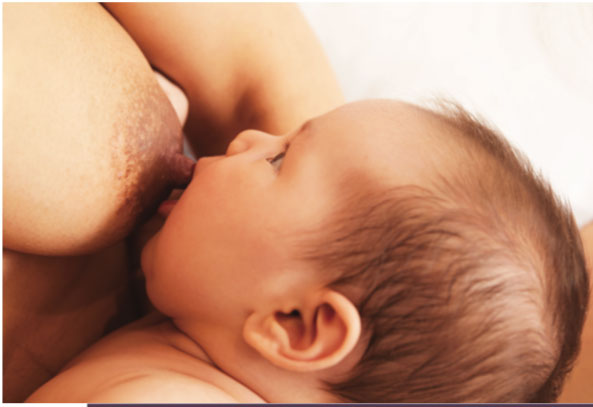
You’re about to begin one of the most exciting and rewarding tasks as a Mummy – nourishing your child. We help you make the best start
Your body is amazing. Not only can it carry and nurture a baby from conception to birth, it can continue to feed your baby for the next six months too. This is the first in a series of features to help you get a great start with feeding your baby – and to help you to feed for longer.
Soon after your baby is born, your midwife will encourage you to put her to the breast. As both you and baby are totally new to this, it may take a few tries to get it just perfect. You’ll be feeding every few hours in the first few weeks, so you’ll get plenty of practice to help you both master this new skill and it’s really useful to get advice from your midwife while you are still in the birthing unit to learn and maintain a good routine.
See our new feature Troubleshooting for Breastfeeding with Eilis Mackie, Lead for Lactation and Infant feeding at The Portland Hospital
Before the birth; can I prepare for breastfeeding
The best thing you can do to prepare for breastfeeding is to be educated – as they say, knowledge is power. The more you know, the better prepared you will be. Be prepared for it to feel a little strange at first, as you and your baby may not ‘know instinctively’ what to do – your first successful feeds are often trial and error and you should ask for help and advice from your midwife.
You don’t need to do much before the birth to prepare your breasts for feeding your baby – the great news is that your body does most of the work for you. Your breasts will get larger and your milk ducts increase in number and you may notice new little bumps around your nipples too. Some women have a few drops of watery fluid that leak out and this is colostrom – of which, more later.
You can, however, prepare an area that’s comfy for you to feed – in your bedroom is usually the best place, so you can do the night feeds as close
to your own bed as possible (you’ll have your baby in your own room with you for at least the first six months).
If you have a comfortable chair, that’s ideal, otherwise you might think about buying a nursing chair and footstool. A pregnancy or feeding pillow is great for propping your baby in a good position for a feed, or use cushions and pillows to get you and baby in a comfy position. You also need a place for a glass of water, as feeding is thirsty work. Some women prefer to feed on the bed, others on the sofa but just make sure you have all you need!
Liquid gold; what is colostrum?
The first milk that your baby has is a thick and creamy substance called colostrum. It’s packed with protein and nutrients, like vitamin A and carotenoids, that are perfectly adapted to your newborn’s needs and it helps build up your baby’s immune system in the early days of life thanks to a high concentration of white blood cells.
A substance called ‘slg A’ helps your baby’s intestinal function too, protecting her against illnesses and building up the ‘good’ bacteria in your baby’s gut. Finally, it helps your baby poo frequently, excreting the high quantity of red blood cells your baby is born with; this is important to prevent jaundice.
Has my milk come in?
This is one of the most common questions women ask. Around two to four days after the birth, the so consistency of your milk will change from colostrum to ‘proper’ milk and your breasts will suddenly feel much harder and bigger – you’ll know that your milk has arrived. In fact, if you have to ask if your milk has come in, it’s likely that it probably hasn’t!

How to burp your baby
Another one of the mysteries of parenting is burping your baby. A newborn does not have the necessary muscle tone to be able to bring up the air that is swallowed along with milk and this may lead to a very unhappy baby, as trapped wind in the intestinal tract can cause pain. Try to wind not only after each feed but in the middle of one, too. Once your baby seems fairly satisfied with the amount of milk she has taken from the first breast you offer, place her on your shoulder and gently pat and rub her back until she brings up wind. Make sure you have a muslin handy, as there’s often some milk mixed in too. Remember that there is always wind there, so don’t give up too soon! Once the wind is out, offer the other breast so that your baby’s tiny tummy is full – then wind again. If your baby suffers badly from wind, try to feed with her head higher than her tummy.


Is my baby getting enough?
Another question many women ask is if they are producing enough milk to satisfy their baby. While your supply is establishing itself, you may feel as consistency of your milk will change from colostrum to ‘proper’ milk and your breasts will suddenly feel much harder and bigger – you’ll know that your milk has arrived. In fact, if you have to ask if your milk has come in, it’s likely that it probably hasn’t!
Another question many women ask is if they are producing enough milk to satisfy their baby. While your supply is establishing itself, you may feel as if you’re feeding all the time but you may still be worried that your baby is hungry. Add to that the fact that babies naturally lose a little weight, up to 10% of their birth weight, after birth (as they pass urine and meconium, those first, dark blackish-greenish poos) and it’s no wonder some of us worry. By the age of four or five days, your baby should stop losing weight, and she should be back up to her birth weight by around 10 days. As long as your baby is having several wet, and a few dirty, nappies a day, you know they are feeding successfully. If you’re worried that she isn’t gaining weight after a few days, talk to your midwife. A change of position may help, as does bringing up your baby’s wind during and after each feed.
Tips for after the feed
Your breasts are the perfect way to feed your baby but this is the first time they have been put to use, so caring for them can help prevent problems. Allow your nipples to dry completely after a feed and wear breast pads in your bra to keep the skin dry between feeds to avoid chaffing and soreness. If you do have any soreness, breast milk is incredibly healing, so squeeze a few drops out and rub into your nipples. A good flavour- and fragrance-free nipple balm or cream is ideal to put on after each feed too.
Flat or inverted nipples?
We all have different shaped breasts and nipples and this won’t affect your ability to breastfeed. However, if you have flat or inverted nipples, it may take a little patience in the early days. You can help draw them out by pinching gently either side or by using shaped breast shells from the fifth month of pregnancy; there is a simple hand-held device to draw out your nipple too. Your baby will probably still be able to latch on and you can feed from your affected breast; you can also try using a breast pump to draw the nipple out just before a feed, or feed from one side while using a pump or expressing by hand to get a start. If all else fails, you can express and feed your baby that way or even feed from one side only, if only one’s affected.
